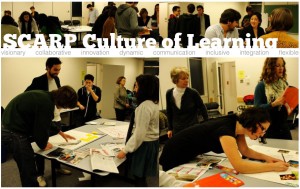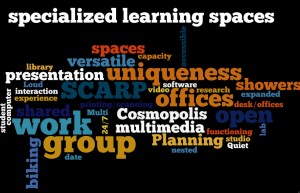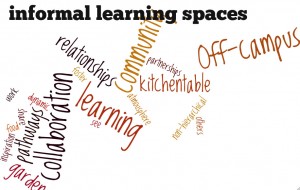Many of you (hundreds, in fact) have been following my posts about the new SCARP/SALA building. As you know, Shape Architecture/FeildenCleggBradley Studios (architects) and PWL Partnership (landscape architects) will be producing a feasibility study and the anticipated full design for the UBC Integrated Planning and Design Facility. Andrew Harrison (DEGW), a leading expert in learning environments, and Atelier 10 are also involved. In addition to the public events planned this semester, an IPD Working Group has been created with the design team and representatives from all the stakeholders: SCARP Masters students, PhD students and faculty; SALA Masters students and faculty; UBC Properties Trust, Buildings Operations, Campus and Community Planning and Infrastructure Development; the Belkin Art Gallery, Applied Science, and the Faculty of Arts. I am a PhD rep, with fellow SCARP students Rohit Mujumdar (PhD), Erica Lay (Masters) and Jessie Singer (Masters), so I have an inside view into this stage of the design process. I’ll be providing regular updates on this after the three “event weeks” that are planned: Learning Landscapes (Jan 14th), Spaces for Learning (Feb 11), and Low Energy Landscapes (March 25).
Each Event Week begins with a kickoff event in a social environment, then there is a public lecture on campus, and an all-day IPD Working Group workshop. This week was focused on Learning Landscapes.
The kick-off event was held downtown and got a great turnout. The public lecture featured presentations by Andrew Harrison and Peter Clegg, and short segués by Nick Sully and Alec Smith from Shape, and Derek Lee from PWL. Andrew’s presentation did a great job of showing different types of learning environments at universities and colleges: from specialized spaces (science labs, workshops, computer labs) to general use spaces (student lounge, reading room, café). Even hallways can be designed to facilitate conversation and collaboration (he called them “learning corridors”). I’m hoping Andrew will make his presentation available online so you can all see it.
The Working Group meets every two weeks, including the workshops each month during the Event Weeks. For this first workshop, we were asked to consider questions such as “How does a changing studio culture within architecture resonate with SCARP and the Arts?” and “How much time do students/faculty spend teaching/researching/writing/drawing/discussing ideas?”  We were asked to submit images that represented the culture of learning in our programs. Then at the workshop, we discussed these ideas in more depth, both in large-group and small-group conversations. The five images shown on the right were provided by the SCARP Masters reps. (Outside of the IPD Working Group, SCARP is running a Directed Studies class, which will be meeting regularly with the design team to discuss their ideas. The students organized a survey, held a visioning workshop and presented the responses to the survey in the format of images to the Working Group.) The text images (general, specialized, and informal learning spaces) were produced with Wordle, which allows you to represent the number of times each word/concept was raised by font size (similar to my website’s “tag cloud” on the right).
We were asked to submit images that represented the culture of learning in our programs. Then at the workshop, we discussed these ideas in more depth, both in large-group and small-group conversations. The five images shown on the right were provided by the SCARP Masters reps. (Outside of the IPD Working Group, SCARP is running a Directed Studies class, which will be meeting regularly with the design team to discuss their ideas. The students organized a survey, held a visioning workshop and presented the responses to the survey in the format of images to the Working Group.) The text images (general, specialized, and informal learning spaces) were produced with Wordle, which allows you to represent the number of times each word/concept was raised by font size (similar to my website’s “tag cloud” on the right).
It was really interesting to hear from the UBC folks as well as those in the adjacent arts buildings (Music in particular). Some ideas that were discussed were the switch from hand-drawing to digital work in architecture, the need for more social space to discuss ideas, the need for a shift in educational approaches, and the possibilities for shared infrastructure (like photocopying/printing space). Another interesting idea was having faculty offices closely aligned to the student workspaces:  Larry Frank from SCARP said he’d like his office to be closer to the transportation modelling lab and also students who use the space. Peter Clegg told us about his virtually paperless office in Bath, where there are no drawing tables at all because everything is done digitally. Scott Watson, curator of the Belkin Art Gallery, raised the idea of having informal exhibition space available in the studios so that students could look at each other’s work as it progressed, and we discussed the idea of “open studio week” where students would host visitors from the broader campus and community.
Larry Frank from SCARP said he’d like his office to be closer to the transportation modelling lab and also students who use the space. Peter Clegg told us about his virtually paperless office in Bath, where there are no drawing tables at all because everything is done digitally. Scott Watson, curator of the Belkin Art Gallery, raised the idea of having informal exhibition space available in the studios so that students could look at each other’s work as it progressed, and we discussed the idea of “open studio week” where students would host visitors from the broader campus and community.
However, as a research-based program, I still feel that SCARP’s needs are not being addressed: Peter actually admitted that we needed to tell him what we meant by research. SCARP Director Penny Gurstein and Larry Frank both raised the issue of research space, but all of us still felt the issue needed to be further discussed. Larry’s definition of a studio was a good fit for SCARP (a space where people learn in a collaborative way), and the studio culture is changing so much anyway: no need for glassed-in spaces when everyone works on  computers. When I said that most SCARP students would graduate without ever drawing anything, Peter asked if that was okay. I think it is, but then I may be biased because I already have those skills from my undergrad in landscape architecture. I should have asked if it’s okay that SALA students graduate without knowing participatory planning or municipal planning processes? We have a lot to learn from each other: many SCARP students would like to learn how to draw, read plans and understand design terminology, and likewise I think SALA students would like to learn about how to build the structures and landscapes they want within the current planning framework and processes. I also think SCARP students could learn how to represent written work in a visual format through diagramming, short film/animations, and the like; and as a former landscape architecture student myself, I imagine that the SALA students could benefit from more attention to their research and writing skills.
computers. When I said that most SCARP students would graduate without ever drawing anything, Peter asked if that was okay. I think it is, but then I may be biased because I already have those skills from my undergrad in landscape architecture. I should have asked if it’s okay that SALA students graduate without knowing participatory planning or municipal planning processes? We have a lot to learn from each other: many SCARP students would like to learn how to draw, read plans and understand design terminology, and likewise I think SALA students would like to learn about how to build the structures and landscapes they want within the current planning framework and processes. I also think SCARP students could learn how to represent written work in a visual format through diagramming, short film/animations, and the like; and as a former landscape architecture student myself, I imagine that the SALA students could benefit from more attention to their research and writing skills.
Another alarming comment: when Leslie Van Duzer, Director of SALA, discussed the three areas used in assessing faculty for tenure (teaching, research and service), one of the SHAPE architects asked what service was. Now this  could just be a terminology issue, but it’s also possible that SALA does a lot less community service than SCARP. Both Larry and Leslie raised the need for specific spaces that could be used for community meetings and to welcome visitors to the new building. Of course service means more than that (participation in groups such as the IPD Working Group or on committees/councils for your professional association are also service activities), but I get the sense that because architecture isn’t a field where all the faculty are PhD-holders with tenure-track positions, there’s a weak understanding of both research and service.
could just be a terminology issue, but it’s also possible that SALA does a lot less community service than SCARP. Both Larry and Leslie raised the need for specific spaces that could be used for community meetings and to welcome visitors to the new building. Of course service means more than that (participation in groups such as the IPD Working Group or on committees/councils for your professional association are also service activities), but I get the sense that because architecture isn’t a field where all the faculty are PhD-holders with tenure-track positions, there’s a weak understanding of both research and service.
At the end of Event Week 1, I’m cautiously optimistic about the IPD design process. There seems to be a great deal of interest from all the stakeholders and the public, people are raising many innovative ideas and willing to collaborate with each other, and there’s a general feeling of trust among the various players. But there are definitely some issues that need to be worked out: a better understanding of SCARP’s teaching and learning processes, a governance model for the new building (considering that SCARP and SALA are under two different administrative units), and the issues of research and service. It’s also unclear how much these workshops will influence the design: how will the design team use our ideas and responses to their thought-provoking questions? Planning students and faculty will continue to watch the process closely, since “that’s what planners do.”
If you’re interested in keeping up with the IPD process, or giving the design team feedback on any element of the process so far, go to ubcipd.wordpress.com. The site has photos from the events, news from the design team, and details on upcoming public lectures. Here’s the current list, but any changes would be listed on the website.
Event Week 2: Space for Learning
Public Kick-off Event February 11, 2011 5:30-6:00 pm Lasserre Lobby
Public Lecture February 21, 2011 6:30-7:45 pm Math 100
Working Committee Workshop February 22, 2011 8:30-4:30 pm Liu Centre Multipurpose Room
Event Week 3: Low Energy Landscapes
Public Kick-off Event March 25, 2011 5:30-6:00 pm Lasserre Lobby
Public Lecture March 28, 2011 6:30-7:45 pm Math 100
Working Committee Workshop March 29, 2011 8:30-4:30 pm Liu Centre Multipurpose Room
